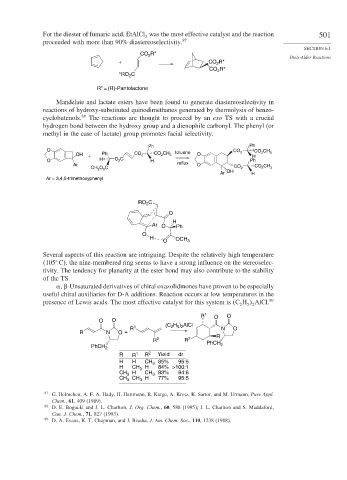Page 527 - Advanced Organic Chemistry Part B - Reactions & Synthesis
P. 527
For the diester of fumaric acid, EtAlCl was the most effective catalyst and the reaction 501
2
proceeded with more than 90% diastereoselectivity. 87
SECTION 6.1
CO R*
2
Diels-Alder Reactions
+ CO R*
2
CO R*
2
C
*RO 2
R* = (R)-Pantolactone
Mandelate and lactate esters have been found to generate diastereoselectivity in
reactions of hydroxy-substituted quinodimethanes generated by thermolysis of benzo-
cyclobutenols. 88 The reactions are thought to proceed by an exo TS with a crucial
hydrogen bond between the hydroxy group and a dienophile carbonyl. The phenyl (or
methyl in the case of lactate) group promotes facial selectivity.
Ph Ph
O CO CO CH
OH + Ph CO 2 CO CH 3 toluene O 2 H 2 3
2
O H O 2 C H Ph
Ar reflux O CH
CH O C CO 2 CO 2 3
3
2
Ar OH H
Ar = 3,4,5-trimethoxyphenyl
C
RO 2
O
H
Ar O Ph
O
H OCH
O 3
Several aspects of this reaction are intriguing. Despite the relatively high temperature
105 C , the nine-membered ring seems to have a strong influence on the stereoselec-
tivity. The tendency for planarity at the ester bond may also contribute to the stability
of the TS.
-Unsaturated derivatives of chiral oxazolidinones have proven to be especially
useful chiral auxiliaries for D-A additions. Reaction occurs at low temperatures in the
presence of Lewis acids. The most effective catalyst for this system is C H AlCl. 89
2 5 2
R 1 O O
O O (C H ) AlCl
R 1 2 5 2 N O
R N O + R
R 2 R 2
PhCH 2
PhCH 2
R R 1 R 2 Yield dr
H H CH 3 85% 95:5
H CH H 84% >100:1
3
CH H CH 3 83% 94:6
3
CH CH H 77% 95:5
3
3
87
G. Helmchen, A. F. A. Hady, H. Hartmann, R. Karge, A. Krotz, K. Sartor, and M. Urmann, Pure Appl.
Chem., 61, 409 (1989).
88 D. E. Bogucki and J. L. Charlton, J. Org. Chem., 60, 588 (1995); J. L. Charlton and S. Maddaford,
Can. J. Chem., 71, 827 (1993).
89
D. A. Evans, K. T. Chapman, and J. Bisaha, J. Am. Chem. Soc., 110, 1238 (1988).

